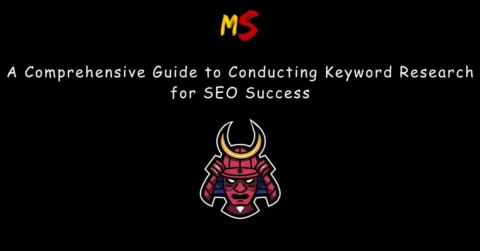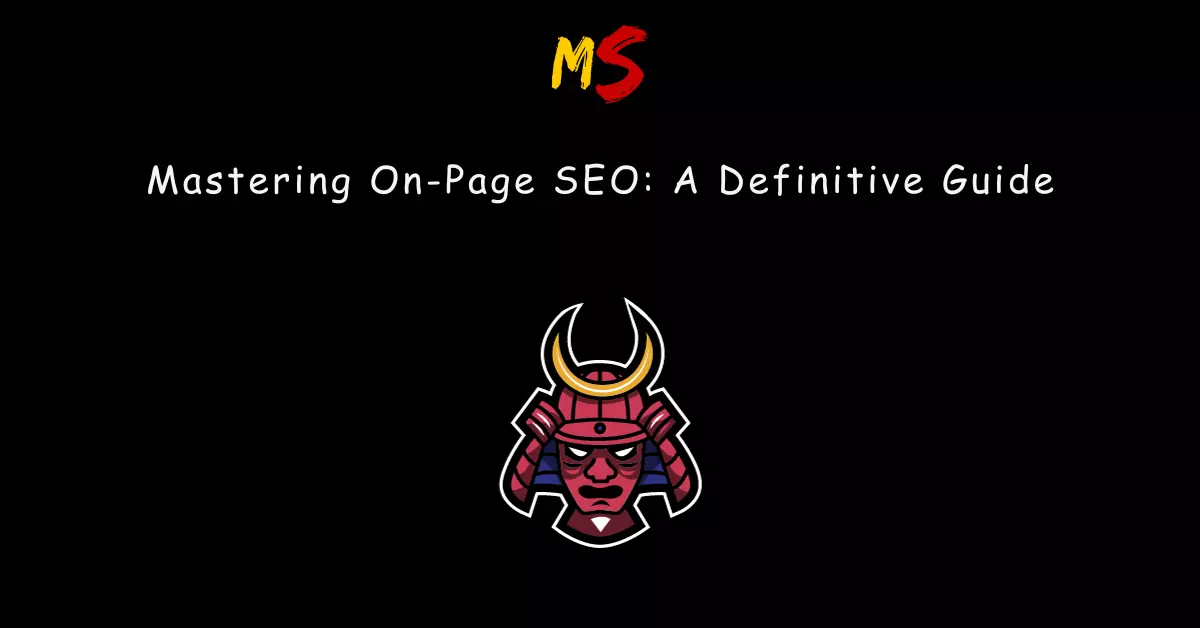Hello, I’m Yash Setpal, the founder of Marketing Senpai. Today, I’m thrilled to take you on a thorough journey into the world of keyword research for SEO success. In the fast-evolving landscape of digital marketing, staying ahead of the curve is essential, and mastering keyword research is your passport to achieving higher search engine rankings and driving substantial organic traffic.
With years of experience in helping businesses thrive online, I’m excited to share an in-depth guide as part of my Digital Marketing Blog, replete with step-by-step explanations, practical examples, and personal tips. By the time we’re done, you’ll be well-equipped to harness the power of effective keyword research. Let’s embark on this enlightening journey together!
Chapter 1: Understanding the Basics
1.1 What are Keywords?
Keywords are the building blocks of SEO. They are the words or phrases that individuals use when searching for information on search engines. Essentially, keywords are the questions and topics your target audience is seeking answers to. For instance, if you operate a bakery in New York City, keywords like “best cupcakes in NYC” or “gluten-free cupcake delivery” are highly relevant.
Personal Tip: When brainstorming keywords, think like your customers. Consider what words they would type into a search engine to find your products or services.
1.2 Why is Keyword Research Important?
Keyword research forms the bedrock of your SEO strategy for several compelling reasons:
Audience Targeting: Identifying the right keywords ensures your content reaches an audience genuinely interested in what you offer.
Competitive Edge: Analyzing your competitors’ keyword strategies can help you leapfrog them in search engine rankings.
Content Relevance: Understanding the intent behind keywords empowers you to create content that directly addresses the needs and queries of your audience.
Chapter 2: The Keyword Research Process
Now that we’ve established the importance of keywords, let’s delve into a systematic, step-by-step approach to conducting keyword research.
2.1 Brainstorming
Kickstart your keyword research by brainstorming a list of potential keywords that are relevant to your business or niche. Put yourself in your target audience’s shoes and think about what they might search for. For our bakery example, brainstormed keywords could include “cupcake flavors,” “custom cake orders,” and “NYC pastry shops.”
Personal Tip: Collaborate with your team or colleagues during this brainstorming session. Different perspectives can uncover unique keywords you might have missed.
2.2 Competitor Analysis
A goldmine of keyword ideas lies in analyzing your competitors’ websites. Utilize tools like Ahrefs or SEMrush to discover which keywords are driving traffic to their sites. Identify keywords that overlap with your business and consider incorporating them into your strategy.
Personal Tip: Focus on competitor keywords that are relevant and have a substantial search volume. It’s not about copying them but gaining insights.
2.3 Keyword Research Tools
Keyword research tools are indispensable for expanding your keyword list and obtaining valuable insights. Prominent tools like Google’s Keyword Planner, Ubersuggest, and Moz Keyword Explorer provide data on search volume, competition, and related keywords, aiding in informed decision-making.
Personal Tip: Don’t limit yourself to a single tool; each has its strengths. Combining insights from multiple tools can give you a comprehensive view of keyword opportunities.
2.4 Long-Tail Keywords
Don’t underestimate the potential of long-tail keywords. These longer, more specific phrases may have lower search volume, but they often indicate higher user intent. For instance, “gluten-free chocolate cupcakes delivery in NYC” is a long-tail keyword.
Personal Tip: Targeting long-tail keywords can be a strategic advantage, as they often have less competition and cater to specific user needs.
2.5 Consider User Intent
Understanding user intent behind keywords is pivotal. Are people searching for information, products, or services? Tailor your content to match the intent behind the keywords you’re targeting. This ensures your content aligns with what your audience is seeking.
Personal Tip: Use descriptive action words like “buy,” “how to,” or “best” to decipher user intent. For instance, “buy cupcakes online” indicates a transactional intent.
Chapter 3: Refining Your Keyword List
With a list of potential keywords in hand, it’s time to refine and prioritize them effectively.
3.1 Search Volume vs. Competition
Balancing search volume with competition is a delicate art. High-volume keywords are attractive but often fiercely competitive. To strike the right balance, consider mixing in low and medium-volume keywords to gain traction.
Personal Tip: A mix of high, medium, and low-competition keywords can create a well-rounded SEO strategy that yields results both in the short and long term.
3.2 Relevance
Relevance is paramount when selecting keywords. Ensure the keywords you choose are highly pertinent to your content and business. For example, if your bakery specializes in cupcakes, targeting keywords related to wedding cakes might not align with your offerings.
Personal Tip: Use Google Trends to gauge the relevance and seasonality of keywords. This can help you identify keywords that are trending or declining in popularity.
3.3 Long-Tail Keywords
Long-tail keywords deserve your attention. Despite lower search volumes, they often attract highly engaged users. By targeting them, you can cater to specific needs within your niche.
Personal Tip: Long-tail keywords can be particularly effective for blog posts and informative content, where users seek detailed answers or solutions to specific problems.
Chapter 4: Creating Optimized Content
Armed with your refined keyword list, it’s time to create content that’s not only optimized for SEO but also engaging and valuable for your audience.
4.1 On-Page SEO
Optimize your content by strategically placing your chosen keywords in titles, headings, and throughout the body text. However, it’s crucial to maintain a natural flow and avoid keyword stuffing, which can harm your rankings.
Personal Tip: Crafting captivating titles that include your target keyword can significantly improve click-through rates from search engine results pages (SERPs).
4.2 High-Quality Content
Remember that SEO isn’t solely about keywords; it’s also about providing value. Create in-depth, informative, and engaging content that genuinely helps your audience. Google rewards content that comprehensively answers user queries.
Personal Tip: Conduct thorough research and aim to provide more valuable and detailed information than what’s currently ranking on the first page of search results.
4.3 Mobile Optimization
As mobile devices continue to dominate search traffic, ensure your content is mobile-friendly. Google’s mobile-first indexing means that your website’s mobile version is considered the primary source for ranking and indexing.
Personal Tip: Test your website’s mobile responsiveness using Google’s Mobile-Friendly Test tool and make necessary adjustments.
Chapter 5: Monitoring and Iterating
Keyword research is an ongoing process. To maintain and improve your SEO performance, it’s essential to monitor your rankings and keyword performance over time.
Personal Tip: Keep a close eye on the performance of your keywords using tools like Google Analytics and Search Console. Regularly update and refresh your content to ensure its relevance.
Chapter 6: Local SEO Strategies
For businesses with physical locations, optimizing for local search is crucial. Implementing local SEO strategies can help you connect with potential customers in your vicinity.
6.1 Google My Business (GMB)
Set up and optimize your Google My Business profile. Ensure that your business’s name, address, and phone number (NAP) are consistent across all online platforms.
Personal Tip: Encourage satisfied customers to leave reviews on your GMB profile, as positive reviews can boost your local search rankings.
6.2 Local Keywords
Incorporate location-specific keywords into your content. For instance, if you’re a bakery in Manhattan, include keywords like “Manhattan cupcakes” or “NYC pastry delivery.”
Personal Tip: Participate in local events or sponsorships, and ensure that these are mentioned online, as they can contribute to your local SEO efforts.
Chapter 7: Voice Search Optimization
The rise of voice-activated assistants like Siri and Alexa has given rise to voice search. Optimizing for voice search can give you an edge in reaching users who prefer this method.
7.1 Conversational Keywords
Voice search queries are often more conversational. Incorporate natural language keywords into your content to align with how people speak when using voice search.
Personal Tip: Create FAQ-style content that directly addresses common questions users might ask via voice search.
7.2 Featured Snippets
Strive to earn featured snippets, as they are often read aloud as answers to voice search queries. Structure your content to provide concise, informative answers.
Personal Tip: Format your content using bullet points or numbered lists to increase the chances of earning a featured snippet.
Conclusion
Keyword research is your compass in the vast ocean of SEO. By understanding keywords, user intent, and content optimization, you’re now well-equipped to navigate the ever-evolving landscape of search engine optimization.
Keep in mind that SEO is a marathon, not a sprint. Stay curious, continue learning, and adapt to the ever-changing SEO terrain. With dedication and the right keyword research techniques, your online presence will flourish, just like a perfectly baked cupcake fresh out of the oven. Happy researching!





















